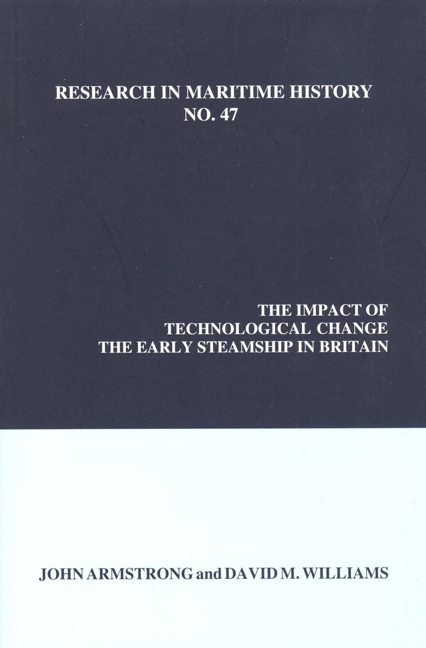Book contents
- Frontmatter
- Contents
- Series Editor's Foreword
- About the Authors
- Introduction
- Chapter 1 British Steam Navigation, 1812 to the 1850s: A Bibliographical and Historiographical Review
- Chapter 2 Some Official Listings of “Vessels Navigated by Steam” in Britain up to 1851: Evidence and Interpretation
- Chapter 3 The Steamboat, Safety and the State: Government Reaction to New Technology in a Period of Laissez-Faire
- Chapter 4 The Steamboat and Popular Tourism
- Chapter 5 The Thames and Recreation, 1815-1840
- Chapter 6 Steam Shipping and the Beginnings of Overseas Tourism: British Travel to North Western Europe, 1820-1850
- Chapter 7 Technological Advance and Innovation: The Diffusion of the Early Steamship in the United Kingdom, 1812-1834
- Chapter 8 The Steamship as an Agent of Modernisation, 1812-1840
- Chapter 9 “A New and Very Modern Business:” The Traffic and Operations of the Early Steamship
- Chapter 10 Promotion, Speculation and Their Outcome: The “Steamship Mania” of 1824-1825
- Chapter 11 The Perception and Understanding of New Technology: A Failed Attempt to Establish Transatlantic Steamship Liner Services, 1824-1828
- Chapter 12 The “Norwich Explosion” of 1817: A Local Tragedy of National Significance
- Chapter 13 Early Steamboat Services and Their Impact in North Wales, 1817-1840s
- Chapter 14 The Beginnings of a New Technology: The Constructors of Early Steamboats, 1812-1822
Chapter 7 - Technological Advance and Innovation: The Diffusion of the Early Steamship in the United Kingdom, 1812-1834
- Frontmatter
- Contents
- Series Editor's Foreword
- About the Authors
- Introduction
- Chapter 1 British Steam Navigation, 1812 to the 1850s: A Bibliographical and Historiographical Review
- Chapter 2 Some Official Listings of “Vessels Navigated by Steam” in Britain up to 1851: Evidence and Interpretation
- Chapter 3 The Steamboat, Safety and the State: Government Reaction to New Technology in a Period of Laissez-Faire
- Chapter 4 The Steamboat and Popular Tourism
- Chapter 5 The Thames and Recreation, 1815-1840
- Chapter 6 Steam Shipping and the Beginnings of Overseas Tourism: British Travel to North Western Europe, 1820-1850
- Chapter 7 Technological Advance and Innovation: The Diffusion of the Early Steamship in the United Kingdom, 1812-1834
- Chapter 8 The Steamship as an Agent of Modernisation, 1812-1840
- Chapter 9 “A New and Very Modern Business:” The Traffic and Operations of the Early Steamship
- Chapter 10 Promotion, Speculation and Their Outcome: The “Steamship Mania” of 1824-1825
- Chapter 11 The Perception and Understanding of New Technology: A Failed Attempt to Establish Transatlantic Steamship Liner Services, 1824-1828
- Chapter 12 The “Norwich Explosion” of 1817: A Local Tragedy of National Significance
- Chapter 13 Early Steamboat Services and Their Impact in North Wales, 1817-1840s
- Chapter 14 The Beginnings of a New Technology: The Constructors of Early Steamboats, 1812-1822
Summary
Technological advance is the outcome less of invention than of innovation, for it is not so much the appearance of a new machine or technique but its dissemination that has an impact on economic growth and the pattern of economic activity. The process of dissemination of new technologies varies both over time and space; some new processes are rapidly and widely taken up, others make but slow and narrow progress. This study examines the diffusion of the steamship in the UK from the commencement of commercial services in 1812 through to the early 1830s, just over two decades later. Underlying this examination are two aims; first, to demonstrate that there was a rapid and nationwide diffusion of steamship services, and second, to explain why this development came about.
Our claim for the rapid diffusion for the early steamship may appear to run contrary to the existing consensus on the spread of steamship services. In 1982, Sarah Palmer observed that “the early history of steam shipping has received little attention from maritime historians except by way of contrast with steam's later spectacular development or as a means of demonstrating the resilience of the sailing ship as a mode of transport.” Such an approach largely still persists, and the prevailing orthodoxy is virtually unanimous in its belief in the slow progress of steam shipping. Only a decade or so ago Robert Gardiner noted that “the coming of steam was a complex and long drawn out affair,” and David Starkey, in the same volume, couched his discussion of steam shipping in terms of why the growth of steam was so slow. Such judgements on the spread of steam power arise from the approach of assessing a new technology on the basis of how soon it replaces, takes over and dismisses an earlier technology. This approach is misleading on a number of counts. First, it is highly unlikely for any new technology to rapidly displace a widespread and long-established existing technology. The latter inevitably embodies a heavy investment of capital that is often capable of continuing to operate on an economic and profitable basis. Moreover, operators of an older technology are unlikely to consider change unless forced by necessity or being convinced of overwhelming advantage.
- Type
- Chapter
- Information
- The Impact of Technological ChangeThe Early Steamship In Britain, pp. 139 - 164Publisher: Liverpool University PressPrint publication year: 2011



